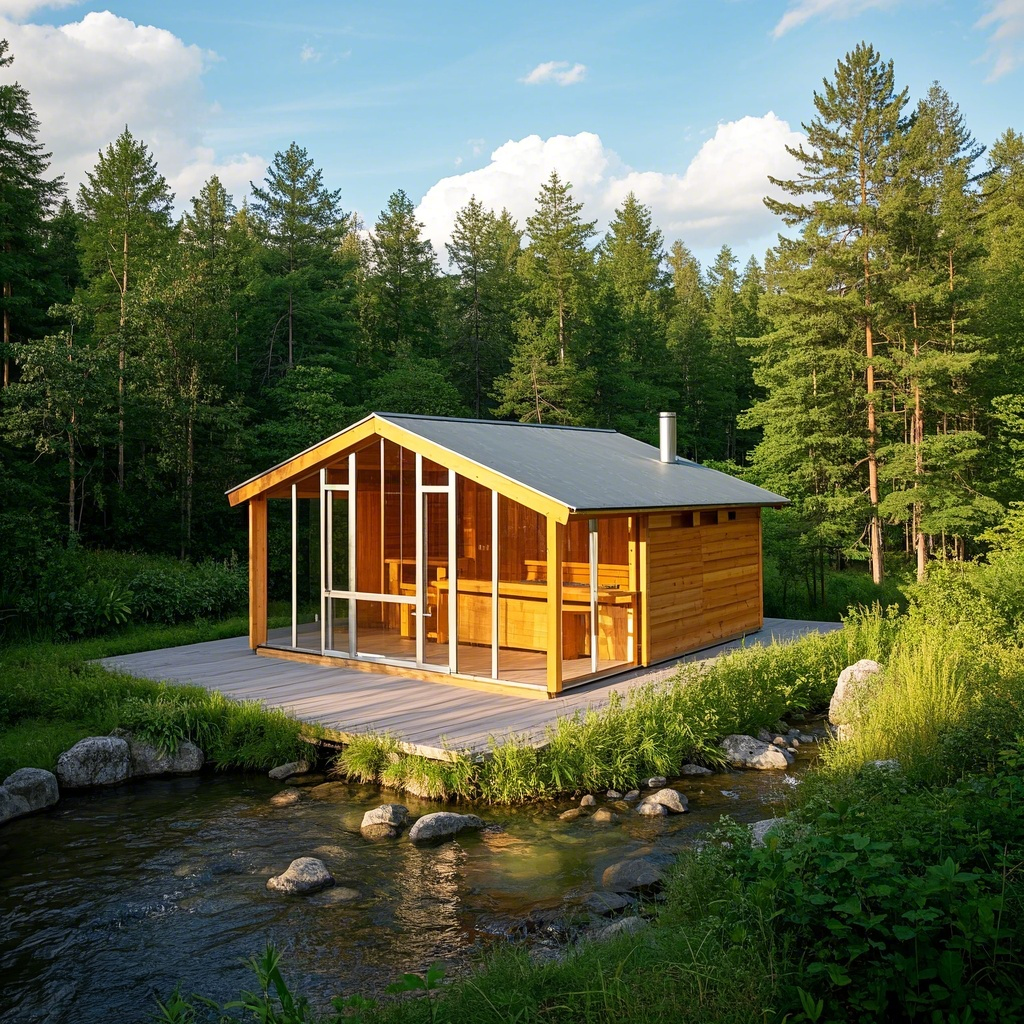
Outdoor saunas can bring people a comfortable sauna experience in the natural environment. Behind this, there is a series of complex and sophisticated technical principles. These principles work together to create a high - temperature, dry or humid environment to meet the different needs of users for saunas.?
I. Heat Transfer Principles?
(A) Radiative Heat Transfer?
In an outdoor sauna, the heater is the core component that generates heat. Whether it is an electric heater, a gas heater, or a wood - burning stove, they all transfer heat to the surrounding space through radiation. Take an electric heater as an example. The resistance wire inside it generates heat when energized, producing infrared radiation. These infrared rays can directly penetrate the air and be absorbed by the wooden structure, human body, and other objects in the sauna. After the wooden material absorbs infrared rays, the molecular vibration intensifies, and the temperature rises, and then the heat is transferred to the air in contact with it. When the human skin absorbs infrared radiation, it will also feel a 明显的 warmth, promoting blood circulation. This is the manifestation of radiative heat transfer in the sauna.?
(B) Convective Heat Transfer?
As the air temperature around the heater rises, the hot air has a lower density and will naturally rise. While the cold air with a higher density will flow to the area around the heater to replenish, forming air convection. This convection makes the heat evenly distributed in the sauna. In the design of an outdoor sauna, the reasonable setting of ventilation openings is crucial for promoting air convection. The hot air is discharged from the top ventilation opening, and the cold air enters from the bottom ventilation opening. In this way, the temperature in the entire sauna is relatively balanced. For example, in a traditional dry sauna, through a cleverly designed ventilation system, the high - temperature hot air can continuously circulate in the room, enabling users in different positions to feel the appropriate heat.?
(C) Conductive Heat Transfer?
The wooden structure in the sauna also plays a role in heat conduction during the heat transfer process. When the heat generated by the heater is transferred to the wooden walls, ceiling, and seats through radiation and convection, as a good heat conductor, wood will transfer the heat from the area with a higher temperature to the area with a lower temperature. This not only helps to maintain the overall high - temperature environment in the sauna but also makes the heat more evenly distributed in every corner. Moreover, when the user sits on the wooden seat, there is also heat conduction between the body and the seat. The heat is transferred from the seat to the human body, allowing the user to feel the warmth of the sauna in all directions.?
II. Humidity Regulation Principles?
(A) Humidity Control in Dry Saunas?
The goal of a dry sauna is to create a relatively dry high - temperature environment, and the humidity is usually controlled at 10% - 20%. To achieve this humidity control, first, it is necessary to ensure the good airtightness of the sauna to reduce the entry of external humid air. At the same time, the continuous high temperature generated by the heater will accelerate the evaporation of water in the room, causing the water to be quickly discharged in the form of water vapor. In addition, the ventilation system takes away part of the water vapor while discharging the hot air, thus maintaining a low humidity level. For example, in some high - end outdoor dry saunas, humidity sensors are equipped to monitor the humidity in the room in real - time, and the ventilation volume and heating power are adjusted through an intelligent control system to accurately control the humidity within the ideal range.?
(B) Humidity Regulation in Wet Saunas?
Wet saunas require a higher humidity, generally 80% - 100%. Its humidity regulation mainly relies on a special steam generator. The steam generator generates a large amount of water vapor by heating water, and these water vapor are released into the sauna, rapidly increasing the air humidity. To maintain stable humidity, the power of the steam generator is usually adjustable, and the steam generation amount is adjusted according to the actual humidity in the room. In addition, the ventilation system design of a wet sauna is different from that of a dry sauna. The ventilation volume is relatively small to reduce the rapid discharge of water vapor and maintain a high - humidity environment. For example, some wet saunas are equipped with water - spraying devices on the walls, which spray water on the walls regularly. After the water evaporates, it can also increase the humidity in the room, working together with the steam generator to create a humid sauna atmosphere.?
III. Ventilation and Air Purification Principles?
(A) Natural Ventilation?
Outdoor saunas mostly adopt a combination of natural ventilation and mechanical ventilation. Natural ventilation mainly relies on thermal pressure and wind pressure to achieve. Thermal - pressure ventilation is based on the principle that hot air rises and cold air descends. As mentioned above, the heated air in the sauna has a high temperature and will be naturally discharged from the top ventilation opening, while the external cold air enters from the bottom ventilation opening, forming a natural air circulation. Wind - pressure ventilation utilizes the effect of outdoor wind. When the wind blows through the sauna, the air pressure on the windward side is higher, and the air pressure on the leeward side is lower. The air will enter the sauna through the ventilation opening on the high - pressure side and be discharged from the low - pressure side, promoting the flow of air. Reasonable design of the location, size, and shape of the ventilation openings can effectively utilize natural ventilation to provide fresh air for the sauna and discharge foul air.?
(B) Mechanical Ventilation and Air Purification?
In addition to natural ventilation, many outdoor saunas are also equipped with mechanical ventilation equipment, such as exhaust fans. Exhaust fans can more efficiently control the air flow rate. Especially when natural ventilation is insufficient, they can quickly discharge the hot air and moisture in the room and supplement fresh air. At the same time, to ensure air quality, some saunas are equipped with air purification devices. For example, some air purifiers with activated - carbon filters can adsorb odors, dust, and harmful gases in the air, such as formaldehyde and benzene, providing users with a fresher and healthier sauna environment. Some air purification devices use ultraviolet sterilization technology to sterilize and disinfect the incoming and outgoing air, ensuring the hygiene of the air in the sauna.?
IV. Temperature Control Principles?
Outdoor saunas maintain an appropriate temperature through a precise temperature control system. The temperature control system mainly consists of a temperature sensor, a controller, and a heater. The temperature sensor is responsible for monitoring the temperature in the sauna in real - time and transmitting the temperature signal to the controller. The controller compares and analyzes the preset temperature value with the actual temperature feedback by the sensor. When the actual temperature is lower than the preset temperature, the controller will issue an instruction to increase the power of the heater, enabling the heater to generate more heat and raise the room temperature. When the actual temperature is higher than the preset temperature, the controller will reduce the power of the heater or temporarily turn off the heater to let the room temperature drop. For example, common electronic thermostats can accurately set the temperature, and the error range is usually within ±1℃, ensuring that the sauna is always in the temperature state expected by the user and bringing users a comfortable and stable sauna experience.


